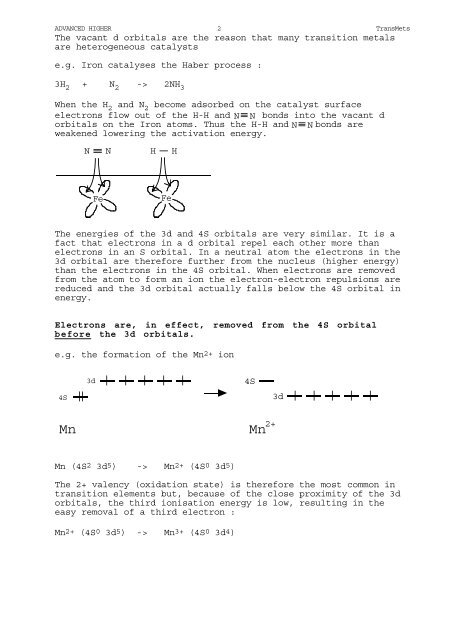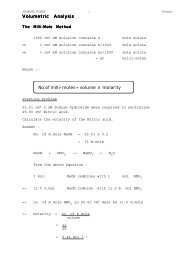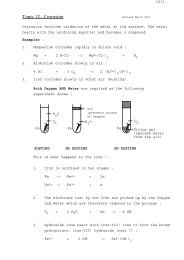Transition Metals - Iandalgleish.co.uk
Transition Metals - Iandalgleish.co.uk
Transition Metals - Iandalgleish.co.uk
You also want an ePaper? Increase the reach of your titles
YUMPU automatically turns print PDFs into web optimized ePapers that Google loves.
ADVANCED HIGHER 2 TransMetsThe vacant d orbitals are the reason that many transition metalsare heterogeneous catalystse.g. Iron catalyses the Haber process :3H 2 + N 2 -> 2NH 3When the H 2 and N 2 be<strong>co</strong>me adsorbed on the catalyst surfaceelectrons flow out of the H-H and N N bonds into the vacant dorbitals on the Iron atoms. Thus the H-H and N N bonds areweakened lowering the activation energy.NNHHFeFeThe energies of the 3d and 4S orbitals are very similar. It is afact that electrons in a d orbital repel each other more thanelectrons in an S orbital. In a neutral atom the electrons in the3d orbital are therefore further from the nucleus (higher energy)than the electrons in the 4S orbital. When electrons are removedfrom the atom to form an ion the electron-electron repulsions arereduced and the 3d orbital actually falls below the 4S orbital inenergy.Electrons are, in effect, removed from the 4S orbitalbefore the 3d orbitals.e.g. the formation of the Mn2+ ion3d4S4S3dMn Mn 2+Mn (4S2 3d5) -> Mn2+ (4S0 3d5)The 2+ valency (oxidation state) is therefore the most <strong>co</strong>mmon intransition elements but, because of the close proximity of the 3dorbitals, the third ionisation energy is low, resulting in theeasy removal of a third electron :Mn2+ (4S0 3d5) -> Mn3+ (4S0 3d4)




